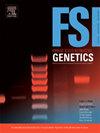Tracking male DNA transfer and survival under female victim fingernails: Insights from a 24-h scratch simulation
IF 3.1
2区 医学
Q2 GENETICS & HEREDITY
引用次数: 0
Abstract
In forensic investigations, the collection of biological material under fingernails may provide important evidence in cases of physical or sexual assault. Among these, scenarios suggesting alternative activities for the presence/absence of the DNA rather than questioning the donor of the trace are particularly challenging. To provide data supporting the interpretation of these cases, we investigated the transfer, persistence, and presence of background male DNA under female fingernails in controlled experiments of simulated scratching. Unlike previous studies, subungual samples were collected over short and long periods, up to 24 h after the scratching without preliminary cleaning of the nails.
Y-STRs data showed that the DNA of the male individual scratched by a woman was detected in fingernail samples collected immediately and up to 6 h post-scratching. A notable decrease in male DNA quantity was observed after the first 3 h of scratching. Interestingly, the same foreign Y-STR profiles, different from the participating individuals, were observed between 6 and 24 h post-simulation. Overall, our data confirm that the detection of the offender’s DNA from subungual samples is very likely immediately after the assault; yet, persistent background or newly transferred DNA may challenge the interpretation of traces collected after 6 h.
Finally, one scenario was discussed to illustrate the value of these data for evaluating fingernail evidence when considering activity-level propositions.
追踪男性DNA转移和女性受害者指甲下的生存:来自24小时划痕模拟的见解
在法医调查中,收集指甲下的生物材料可能为身体或性侵犯案件提供重要证据。其中,提出DNA存在/不存在的替代活动而不是质疑痕迹的供体的方案尤其具有挑战性。为了提供数据支持这些病例的解释,我们在模拟抓挠的对照实验中研究了女性指甲下背景男性DNA的转移、持久性和存在。与以前的研究不同,在没有初步清洁指甲的情况下,在短时间和长时间内收集趾甲下样本,最长可达24 h。Y-STRs数据显示,在被女性抓伤后立即和6 h内采集的指甲样本中检测到被女性抓伤的男性个体的DNA。在抓挠3 h后,雄性DNA数量明显减少。有趣的是,在模拟后的6至24 h之间,观察到与参与个体不同的相同的外来Y-STR谱。总的来说,我们的数据证实,从爪下样本中检测到罪犯的DNA很可能是在袭击发生后立即检测到的;然而,持续的背景或新转移的DNA可能会挑战6 h后收集的痕迹的解释。最后,我们讨论了一个场景来说明这些数据在考虑活动水平命题时评估指甲证据的价值。
本文章由计算机程序翻译,如有差异,请以英文原文为准。
求助全文
约1分钟内获得全文
求助全文
来源期刊
CiteScore
7.50
自引率
32.30%
发文量
132
审稿时长
11.3 weeks
期刊介绍:
Forensic Science International: Genetics is the premier journal in the field of Forensic Genetics. This branch of Forensic Science can be defined as the application of genetics to human and non-human material (in the sense of a science with the purpose of studying inherited characteristics for the analysis of inter- and intra-specific variations in populations) for the resolution of legal conflicts.
The scope of the journal includes:
Forensic applications of human polymorphism.
Testing of paternity and other family relationships, immigration cases, typing of biological stains and tissues from criminal casework, identification of human remains by DNA testing methodologies.
Description of human polymorphisms of forensic interest, with special interest in DNA polymorphisms.
Autosomal DNA polymorphisms, mini- and microsatellites (or short tandem repeats, STRs), single nucleotide polymorphisms (SNPs), X and Y chromosome polymorphisms, mtDNA polymorphisms, and any other type of DNA variation with potential forensic applications.
Non-human DNA polymorphisms for crime scene investigation.
Population genetics of human polymorphisms of forensic interest.
Population data, especially from DNA polymorphisms of interest for the solution of forensic problems.
DNA typing methodologies and strategies.
Biostatistical methods in forensic genetics.
Evaluation of DNA evidence in forensic problems (such as paternity or immigration cases, criminal casework, identification), classical and new statistical approaches.
Standards in forensic genetics.
Recommendations of regulatory bodies concerning methods, markers, interpretation or strategies or proposals for procedural or technical standards.
Quality control.
Quality control and quality assurance strategies, proficiency testing for DNA typing methodologies.
Criminal DNA databases.
Technical, legal and statistical issues.
General ethical and legal issues related to forensic genetics.

 求助内容:
求助内容: 应助结果提醒方式:
应助结果提醒方式:


